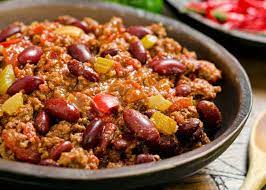How does long can chili last in the fridge and still be safe to eat?
Chili is a delicious and versatile dish that can be enjoyed in various ways. Whether you prefer it spicy or mild, with or without beans, chili is always a crowd pleaser. But what happens when you make a big batch of chili and have leftovers? How long can you keep chili in the fridge before it goes bad?
Proper storage is key to maintaining the quality and safety of your leftover chili. Most chili recipes contain meat, which makes it a potentially hazardous food. Bacteria can multiply quickly in meat dishes, leading to foodborne illnesses if not handled and stored properly. As a rule of thumb, cooked chili can last in the fridge for up to four days.
To ensure that your chili stays fresh and safe to eat for as long as possible, it’s important to cool it down quickly after cooking. Transfer your chili to shallow, airtight containers and place them in the refrigerator within two hours of cooking. This helps prevent the growth of bacteria that can cause food poisoning. Additionally, make sure your fridge is set to a temperature below 40°F (4°C) to slow down bacterial growth.
If you have a large batch of chili that you know you won’t be able to finish within four days, consider freezing it. Chili can be frozen for up to three months without any significant loss in flavor or quality. To freeze chili, divide it into individual portions and store each portion in airtight freezer-safe containers or bags. Label them with the date and use them within three months for the best results.
When it’s time to enjoy your leftover chili, make sure to reheat it properly. The best way to reheat chili is on the stove over medium heat. Make sure the chili reaches a temperature of 165°F (74°C) throughout to kill any bacteria that may have developed during storage. Remember to stir occasionally to ensure even heating.
In conclusion, chili can last in the fridge for up to four days if stored properly. If you have more chili than you can consume within that time frame, freezing is a great option. Just make sure to follow the recommended storage guidelines to enjoy your chili safely and maintain its delicious taste.
Storage Recommendations
Properly storing chili is key to keeping it fresh and safe to eat. Here are some storage recommendations to help you make the most of your chili:
- Allow the chili to cool down before storing it in the fridge. Placing hot chili directly into the fridge can raise the temperature inside and affect the overall quality of the food.
- Transfer the chili to an airtight container or a resealable plastic bag. This will help prevent the chili from absorbing any odors or flavors from other foods in the fridge.
- Label the container or bag with the date that the chili was prepared. This will help you keep track of its freshness and ensure that you use it within a safe timeframe.
- Store the chili in the refrigerator at a temperature of 40°F (4°C) or below. This will slow down the growth of bacteria and help extend the shelf life of the chili.
- Consume the chili within 3-4 days of refrigeration. While chili can last up to 5 days in the fridge, it is best to consume it within the first few days for optimal taste and quality. If you’re not able to finish it within this timeframe, consider freezing it for longer storage.
Remember to always use your best judgment when it comes to food safety. If the chili looks or smells off, it’s best to discard it to avoid any risk of foodborne illness. By following these storage recommendations, you can enjoy your chili for longer and reduce waste.
Factors Influencing Chili Shelf Life
Several factors can influence the shelf life of chili:
Storage conditions: The way chili is stored plays a significant role in determining its shelf life. Chili should always be stored in an airtight container and kept in the refrigerator. Exposure to air and moisture can accelerate spoilage and affect its taste and texture.
Ingredients: The ingredients used in the chili can also impact its shelf life. Fresh ingredients, such as vegetables and meat, have a shorter shelf life compared to canned or preserved ingredients. Using high-quality ingredients can help extend the shelf life of chili.
Food handling practices: Proper food handling practices, such as washing hands before preparing chili, using clean utensils, and preventing cross-contamination, can help prevent the growth of bacteria and extend the chili’s shelf life.
Spices and flavors: Spices and flavors used in chili can also impact its shelf life. Some spices have antimicrobial properties and can help preserve the chili for a longer period. Additionally, strong flavors can mask any off-putting smells or tastes that indicate spoilage.
Initial freshness: The initial freshness of the chili and its ingredients can determine how long it will last. Using fresh ingredients and ensuring the chili is cooked and stored immediately after preparation can help extend its shelf life.
Temperature: The temperature at which chili is stored can significantly affect its shelf life. Storing chili at temperatures below 40°F (4°C) slows down bacterial growth, while temperatures above 40°F (4°C) can promote bacterial growth and spoilage.
Duration of storage: The longer chili is stored, the greater the chance of it spoiling. Ideally, chili should be consumed within 3-4 days of preparation to ensure maximum freshness and quality.
By considering these factors and practicing proper food storage and handling techniques, you can ensure that your chili lasts longer and remains safe to eat.
Signs of Spoiled Chili
Chili is a delicious and hearty dish that can be enjoyed for several days when stored properly in the refrigerator. However, like any food, chili can spoil if not consumed within a certain time frame or if it is not stored correctly. Here are some signs that your chili may have gone bad:
1. Foul odor: If your chili has a strong, unpleasant smell, it is a clear indicator that it has spoiled. The odor may be sour, rancid, or off-putting in any way. Trust your sense of smell and discard the chili if it smells bad.
2. Mold or strange growth: If you notice any signs of mold or strange growth on the surface of your chili, do not consume it. Mold can be harmful to your health and is a sure sign that the chili is no longer safe to eat.
3. Change in color or texture: If your chili has changed in color significantly or if it has developed a slimy texture, it is a sign of spoilage. Fresh chili should have a vibrant red color and a thick, meaty texture. Any deviations from this should be considered a warning sign.
4. Off taste: If your chili tastes off, bitter, or different from what you are used to, it is best to err on the side of caution and discard it. Your taste buds are a reliable indicator of food spoilage, so trust your instincts.
5. Expiration date: Always check the expiration date on the container or package of your chili. Even if stored properly, chili can still spoil past its expiration date, so it is important to use this as a guideline.
6. Unusual gas buildup: If you notice that the container or lid of your chili is swollen or bulging, it is a sign that gas has built up inside and the chili has likely spoiled. Do not consume the chili and dispose of it immediately.
Remember, consuming spoiled chili can result in foodborne illnesses and stomach discomfort. It is better to be safe than sorry, so if you have any doubts about the freshness or safety of your chili, it is best to throw it away.
How to Properly Store Chili in the Fridge
Properly storing chili in the fridge is essential to maintain its freshness and prevent it from spoiling. Here are some guidelines to ensure the longevity and quality of your chili:
1. Cool it down quickly: After cooking your chili, allow it to cool down to room temperature for no more than 2 hours. Leaving it at room temperature for too long increases the risk of bacterial growth.
2. Use airtight containers: Transfer the cooled chili into airtight containers or resealable bags. This helps to prevent air exposure and keeps the chili fresh for a longer period.
3. Label and date: It’s important to label the containers with the date of preparation. This will help you keep track of the chili’s freshness and avoid consuming expired leftovers.
4. Store in the fridge: Place the airtight containers or resealable bags in the refrigerator. The ideal temperature for storing chili is below 40°F (4°C). Make sure the chili is stored in the coldest part of the fridge, such as the bottom shelf or the back area.
5. Consume within 3-4 days: Chili can typically last in the fridge for 3 to 4 days if stored properly. Beyond this time, the quality may deteriorate, and it’s best to discard any leftovers.
6. Reheat properly: When reheating chili, make sure to heat it thoroughly to an internal temperature of 165°F (74°C) to kill any potential bacteria. Use a microwave or stovetop, and stir occasionally to ensure even heating.
7. Freezing option: If you have excess chili and don’t plan on consuming it within 3-4 days, consider freezing it. Transfer the chili into freezer-safe containers or bags, leaving some space for expansion. Store it in the freezer for up to 3 months, and thaw it in the fridge before reheating.
By following these tips, you can enjoy delicious and safe chili for several days, maximizing its shelf life and minimizing food waste.
Tips for Extending Chili’s Shelf Life
Chili can be a delicious and satisfying meal, but it’s important to properly store and handle it to ensure its freshness and longevity. Here are some tips for extending the shelf life of your chili:
1. Proper Storage
When storing chili in the fridge, make sure to keep it in an airtight container or a sealed plastic bag. This will help prevent any odors from getting into the chili and keep it fresh for longer.
2. Cool It Down Quickly
After cooking or reheating chili, cool it down quickly before storing it in the fridge. Divide it into smaller portions as larger containers take longer to cool down. This helps prevent bacteria growth and ensures the chili stays safe to eat for a longer period of time.
3. Use Fresh Ingredients
The quality and freshness of the ingredients used in your chili can affect its shelf life. Make sure to use fresh vegetables, meat, and spices when preparing your chili. Using high-quality ingredients can help prolong its freshness.
4. Avoid Cross-Contamination
When storing chili in the fridge, keep it separate from other foods, especially raw meat and seafood. This helps avoid cross-contamination, which can lead to foodborne illnesses.
5. Freeze for Longer Storage
If you want to extend the shelf life of your chili even further, consider freezing it. Transfer the chili into airtight freezer-safe containers or freezer bags, leaving some room for expansion. Frozen chili can last for several months.
By following these tips, you can ensure that your chili stays fresh and safe to eat for a longer period of time. Enjoy your delicious chili whenever you’re in the mood for a warm and comforting meal!
Creative Ways to Use Leftover Chili
Leftover chili can be transformed into delicious dishes that are perfect for quick and easy meals. Here are some creative ways to use your leftover chili:
1. Chili Tacos
Make a tasty taco filling by heating up your leftover chili and spooning it into soft tortilla shells. Top with shredded cheese, diced onions, fresh cilantro, and a squeeze of lime juice. Serve with sour cream and guacamole for a satisfying and flavorful meal.
2. Chili Mac and Cheese
Combine your leftover chili with cooked macaroni and cheese for a comforting and hearty dish. Simply mix the chili and macaroni together, then sprinkle with additional shredded cheese and bake until bubbly and golden. This fusion of flavors will have your taste buds begging for more.
These are just a couple of ideas to help you use up your leftover chili. Get creative and experiment with different recipes to find your favorite way to enjoy this versatile dish!
“FAQ:” How long does chili last in the fridge
How long does chili stay good in the fridge?
Chili can stay good in the fridge for about 3-4 days if stored properly.
Can you tell if chili is still good just by its appearance and smell?
Yes, you can often tell if chili is still good by checking its appearance and smelling it. If it looks and smells normal, it’s likely still good to eat.
What factors determine how long chili is good in the fridge?
The duration chili stays good in the fridge depends on factors such as ingredients, proper refrigeration, and whether it contains meat.
How long will leftover chili last in the fridge?
Leftover chili can last for about 3-4 days in the fridge, maintaining its quality if stored correctly.
What are signs that indicate chili has gone bad?
Signs of bad chili include an off smell, unusual color, slimy texture, or the presence of mold. If any of these are noticed, it’s best to discard the chili.
Is it safe to refrigerate chili for up to 4 days?
Yes, refrigerating chili for up to 4 days is safe, provided it’s stored in an airtight container and promptly refrigerated.
How can you determine if chili is still good even after 4 days in the fridge?
If chili still looks and smells normal after 4 days in the fridge, it’s likely still good to eat. However, it’s essential to follow proper storage and refrigeration practices.
What should you do if you’re wondering how long chili without meat can last in the fridge?
Chili without meat can last in the fridge for about 4-5 days, depending on the freshness of other ingredients and proper storage conditions.
Can chili last in the freezer, and if so, how long?
Chili can last in the freezer for up to 6 months when stored in airtight containers or heavy-duty freezer bags.
What is the best way to store chili for reheating later?
The best way to store chili for reheating later is to cool it to room temperature, then refrigerate it in an airtight container or freeze it in heavy-duty freezer bags. Proper storage helps maintain its taste and quality.
How long is chili good in the fridge, and what’s the recommended duration?
Chili is typically good in the fridge for about 3-4 days. It’s crucial to refrigerate it promptly to ensure its freshness.
How long will leftover chili last in the fridge before it should be consumed or discarded?
Leftover chili can last in the fridge for up to 3-4 days. Beyond this period, the risk of spoilage increases, and it’s advisable to consume or discard it.
Can you determine how long chili will last based on its ingredients and how it’s stored in the refrigerator?
The duration chili will last depends on factors like ingredients, storage conditions, and proper refrigeration. Attention to these factors ensures its quality over time.
What are noticeable signs that indicate chili is bad and should not be consumed?
Signs of bad chili include an off smell, unusual color, slimy texture, or the presence of mold. If any of these signs are present, it’s best to avoid consuming the chili.
How should leftover homemade chili be stored to ensure it stays good?
To store leftover homemade chili, cool it to room temperature and then refrigerate it within two hours. An airtight container helps maintain its freshness.
Can chili without meat stay safe and still be good for consumption?
Meatless chili can stay safe and good for consumption for up to a week when stored properly in the refrigerator. Factors like ingredients and storage conditions play a role in its longevity.
What should you do if chili smells off after being stored in the fridge overnight?
If chili smells off or has an unpleasant odor after being stored in the fridge overnight, it’s recommended to discard it to avoid potential food safety issues.
Can chili stay safe if it has thawed in the fridge?
Yes, chili can stay safe if it has thawed in the fridge. Thawing in the fridge is a safe method that helps maintain the quality and safety of the chili.
How long can canned chili stay good, and does it differ from homemade chili?
Canned chili can last for an extended period, often up to 1-2 years, depending on the expiration date. Homemade chili has a shorter shelf life and should be consumed within 3-4 days when stored in the fridge.
What is the recommended method for reheating leftover chili?
The best way to reheat leftover chili is either on the stovetop or in the microwave. Ensure it reaches a safe internal temperature before consumption to maintain its taste and quality.


